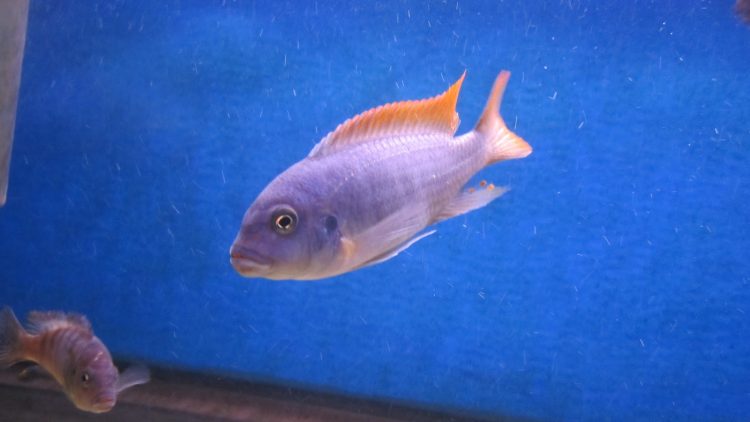
Most people know this fish as the “Red Top Cobalt Zebra” or the “Mbenji Zebra”. It is a beautifully coloured mbuna (rock dwelling fish) from the Mbenji Islands in Lake Malawi. Coloured males are an overall light cobalt blue with red dorsal, caudal and pectoral fins.
Females tend to show more brownish tones with some hints of blue. The female also retains some red in the above mentioned fins but it is not as intense as in males. At Mbenji Island there is an “O.B. “(Orange blotched) form of female as well and these are particularly striking. Mature fish can easily be sexually distinguished by their colouration.
Another similar species from Makokola Reef named Metriaclima greshakei is found in the southeast arm of the lake. These two can be distinguished from each other by the amount of red in the fins. The Makokola type is a bit more intense red but this colour only extends to the halfway point on the caudal and is not present in the pectorals.
And speaking of pectorals, this fish really does have them! (Long, flowing and usually intact). Most bites from other fish are in the caudal area and it was really hard to get a good picture of them in the wild with a good set of fins, even though they were found everywhere around the islands.
Keeping this fish was no problem as long as the tank was of reasonable size, (50 gallons or more). Other species of the same attitude were placed with these fish, like Cynotilapia afra “lion’s cove” and Ps. polit. The fish “grew out” together and it was not long after the first male coloured up that females were observed holding eggs in their mouth.
Twenty-one days post-spawn the females were removed from the aquarium into a 2˝ gallon bucket and the fully formed fry were released from their mouth. The fry went into a 2˝ gallon aquarium filtered with a small “Billy” sponge filter. Fry growth was good and the group soon outgrew this tank and went into a 25 gallon tank.
Initial feeding was baby brine shrimp, and care was taken not to overfeed because they WILL overeat until they burst! When they became a bit larger they greedily took Tetra Mini Bites and growth became a little faster; of course they still got some leftover shrimp, even at this larger size.
Within 7 months the males are starting to colour up and as a larger group in an even larger tank, where they are housed now, are starting to look impressive.
Leave a Reply